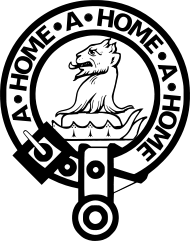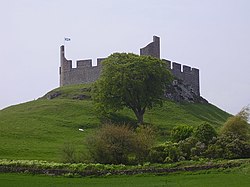Clan Home: Difference between revisions
No edit summary |
Try learning about what Wikipedia is about before making changes. The rules are that you must quote a proper source your message does not count as a source |
||
| Line 4: | Line 4: | ||
|image badge=Clan member crest badge - Clan Home.svg |
|image badge=Clan member crest badge - Clan Home.svg |
||
|chiefs crest= |
|chiefs crest= |
||
|chiefs motto= |
|chiefs motto=A home<ref name="ScotClans"/> |
||
|chiefs slogan=A Home, A Home, A Home |
|chiefs slogan=A Home, A Home, A Home |
||
|war cry= |
|war cry= |
||
Revision as of 08:53, 27 January 2014
| Clan Home | |||
|---|---|---|---|
 | |||
| Motto | A home[1] | ||
| Slogan | A Home, A Home, A Home | ||
| Profile | |||
| Region | Borders | ||
| District | Berwickshire | ||
| Plant badge | Broom[1] | ||
| Chief | |||
 | |||
| David Alexander Cospatrick Douglas-Home | |||
| 15th Earl of Home | |||
| Seat | The Hirsel | ||
| Historic seat | Hume Castle Fast Castle | ||
| |||
| |||
Clan Home (pronounced and sometimes spelt Hume) is a Scottish clan.[2] They were a Border family of immense power.[2]
History
Origins of the clan
The Homes are said to be descended from the Saxon Princes of Northumberland, through Cospatrick, Earl of Dunbar.[2] William de Home appears in land grants to the Monastery of Coldstream before 1266.[2]
In 1296 Geoffrey de Home submitted to Edward I of England.[2] His son was Sir Thomas de Home who married the heiress to the Pepdie estate of Dunglass.[2]
15th century

In 1402 Alexander Home of Dunglass was captured at the Battle of Homildon.[2] Later he followed the Earl of Douglas to France but was killed in battle in 1424.[2] Most of the principal cadet branches of the clan are descended from his three sons.[2] In 1473 his eldest grandson was created a Lord of Parliament, taking the title Lord Home.[2] He joined the rebellion against James II of Scotland which resulted in the death of the king.[2] His son was the second Lord Home who, during the minority of James IV of Scotland, became joint administrator of Berwickshire and the Lothians.[2] He also became Great Chamberlain of Scotland in 1488.[2]
16th century
In 1513, Lord Home and his followers formed part of the army levied by James IV to invade England.[2] Lord Home led the vanguard of Scottish knights at the Battle of Flodden, and while he was fortunate enough to escape the slaughter many of his family and supporters did not.[2] Home was later appointed as one of the counsellors to the Queen Regent.[2] However the fortunes of the Homes suffered when the regency was transferred to the Duke of Albany.[2] Lord Home was arrested for treason after being accused of conspiring with the English and he and his brother were executed in October 1516.[2] Their heads were then displayed on Edinburgh Tolbooth.[2]
The title and estates were later restored to another brother, George Home.[2] On several occasions George Home led Border spearmen against the English.[2] However he was thrown from his horse and died from his injuries on the eve of the Battle of Pinkie Cleugh in 1547.[2] The Home's lands were occupied by the English, however Lord Home's son, the fifth Lord, retook them in 1549.[2] He also supported the Scottish Reformation and sat in the Parliament of 1560 that the passed Protestant Confession of Faith.[2]
During the politics of Mary, Queen of Scots, the Homes, like many others, shifted their allegiance more than once.[2] Lord Home had supported the marriage of the Earl of Bothwell to Mary but he later led his men at the Battle of Langside against the queen.[2] Then in 1573 he was arrested and convicted of treason against the young James VI of Scotland.[2] He was released from Edinburgh Castle only after his health had failed, dieing a few days later.[2] His son, Alexander, the sixth Lord Home, was devoted to James VI and was a royal favourite throughout his life.[2]
17th century and civil war

When James VI of Scotland travelled to England to take possession of his new kingdom in 1603 as James I of England, he stopped at Dunglass and Lord Home accompanied him to London.[2] Home was raised to the title of Earl of Home in March 1605.[2]
The third Earl of Home was a staunch supporter of Charles I of England.[2] In 1648 he was colonel of the Berwickshire Regiment of Foot.[2] In 1650 when Oliver Cromwell invaded Scotland he made a point of seizing Home's castle which was then garrisoned by Parliament's troops.[2]
18th century and Jacobite risings
The Homes also changed sides during the Jacobite risings of the eighteenth century.[2] During the Jacobite rising of 1715, the seventh Earl of Home was imprisoned in Edinburgh Castle.[2] His brother James Home of Ayton had his estates confiscated for his part in the rebellion.[2]
During the Jacobite rising of 1745 the eighth Earl of Home joined British government forces under Sir John Cope at Dunbar.[2] He later fought at the Battle of Prestonpans.[2] The earl rose to the rank of Lieutenant General and was appointed Governor of Gibraltar where he died in 1761.[2]
Henry Home, Lord Kames was a distinguished eighteenth century lawyer who published several important works on Scots law which are still highly regarded.[2] David Hume was perhaps the most highly regarded British philosopher of the eighteenth century.[2]
20th century
The Home family came to prominence in the twentieth century when the fourteenth earl, Alec Douglas-Home, disclaimed his hereditary peerage to become Prime Minister of the United Kingdom.[2] However the peerage title may be revived by his heirs.[2] The Prime Minister's brother was William Douglas-Home who was a distinguished author and play-wright.[2]
Chief
The Rt. Hon. David Alexander Cospatrick Douglas-Home, The 15th Earl of Home, Lord Home, Lord Dunglass, Baron Douglas of Douglas.[3] The previous clan chief was his father, the 14th Earl, better known as Alec Douglas-Home, who was Prime Minister from 1963-1964 and an important politician from the 1930s to the 1970s.
Castles
- Hume Castle was the original seat of the chief of Clan Home, the Earl of Home.
- The Hirsal is the current seat of the Home family.
- Fast Castle, Berwickshire
- Wedderburn Castle, Berwickshire, is the seat of the senior cadet branch, Home of Wedderburn
- Paxton House, Berwickshire
- Hutton Castle, Berwickshire
- Ayton Castle, Berwickshire
- Dunglass Castle, East Lothian
See also
References
- ^ a b Clan Home Profile scotclans.com. Retrieved 6 September 2013.
- ^ a b c d e f g h i j k l m n o p q r s t u v w x y z aa ab ac ad ae af ag ah ai aj ak al am an ao ap aq ar as Way, George and Squire, Romily. Collins Scottish Clan & Family Encyclopedia. (Foreword by The Rt Hon. The Earl of Elgin KT, Convenor, The Standing Council of Scottish Chiefs). Published in 1994. Pages 168 - 169.
- ^ burkes-peerage.net
- Paul, James Balfour (ed.). (1904–14). The Scots Peerage Founded on . . . Sir Robert Douglas’s Peerage of Scotland, 9 volumes.
